How to Change Image Format Online – Quick & Free Guide
10/24/2025
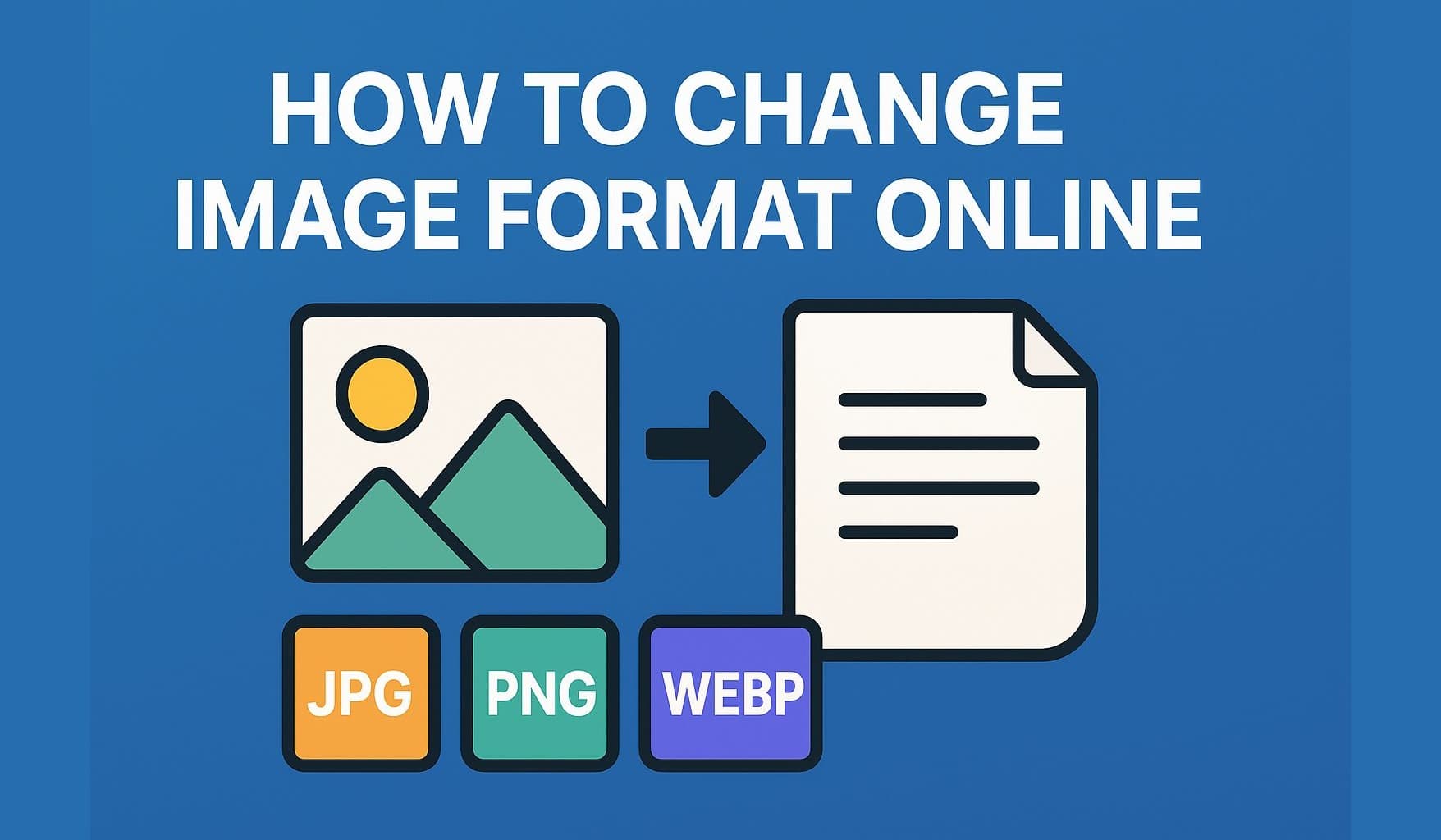
Introduction
Have you ever downloaded an image only to realize it's in the wrong format for what you need? Maybe you're trying to upload a logo to your website, but it only accepts PNG files. Or perhaps you're working on a presentation and need to convert your screenshots from JPG to a more web-friendly format like WEBP. You might even need to convert your images to PDF for a professional document.
Changing image formats shouldn't be complicated, yet many people still struggle with it. Some reach for expensive photo editing software like Photoshop, while others download questionable apps that promise quick conversions but deliver malware instead. And if you've been wondering about which format to use, our guide on JPG vs PNG vs WEBP can help you make the right choice.
The good news? You don't need any of that. With the right online tool, you can change image formats in seconds — right from your browser, without installing anything, and completely free. Beyond just converting formats, you can also compress your images to reduce file size, crop them to the perfect dimensions, or even split them into parts for creative projects.
In this comprehensive guide, we'll walk you through everything you need to know about image formats, why they matter, and how to convert between them effortlessly using ImageToolo's powerful converter. Whether you're a designer, blogger, student, or just someone who works with images regularly, this guide will save you countless hours of frustration.
How to Change Image Format Online with ImageToolo
Now for the main event — let's walk through the actual conversion process. ImageToolo makes this incredibly simple, but I'll give you all the details so you understand exactly what's happening.
🌐 Step 1: Access the Converter
Open your browser and navigate to ImageToolo Image Converter. The interface is clean and intuitive — no cluttered ads or confusing buttons. It works perfectly on desktop, tablet, or phone.
📤 Step 2: Upload Your Image
Click the Upload Image button or simply drag and drop your file into the designated area. ImageToolo accepts virtually any image format you throw at it: JPG, PNG, WEBP, GIF, BMP, TIFF, and more. You can upload a single image or multiple files if you need batch conversion.
The upload is fast and secure. Your files are encrypted during transfer, and the tool doesn't store them on any server permanently.
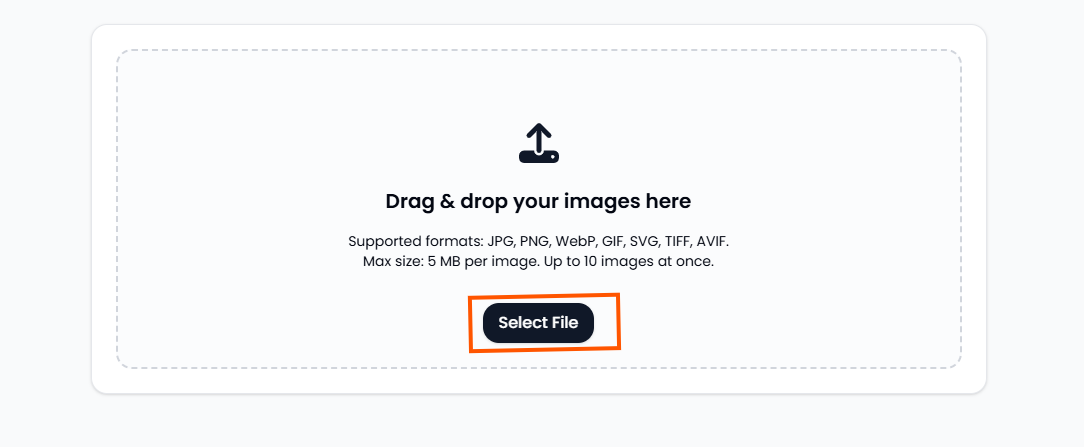
🎯 Step 3: Choose Your Target Format
Once uploaded, you'll see a dropdown menu or selection panel with available output formats. This is where you decide what format you want your image converted to. Each format displays a brief description to help you make an informed choice.
For example:
- Select WEBP for web optimization
- Choose PNG if you need transparency
- Pick JPG for smaller file sizes
- Go with GIF if you're working with simple graphics
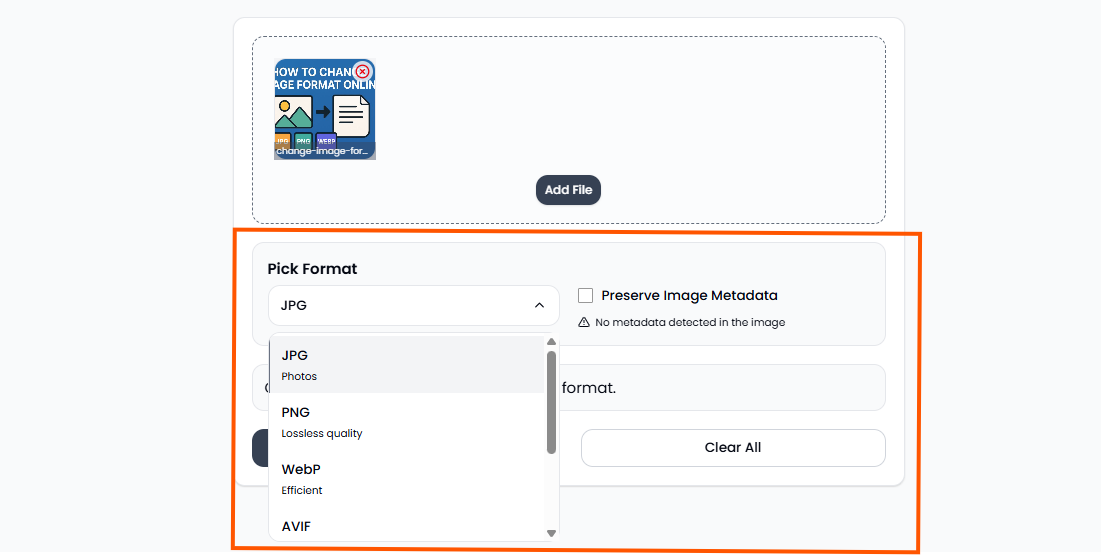
⚙️ Step 4: Adjust Quality Settings (Optional)
Here's where ImageToolo shines. Before converting, you can fine-tune the output:
Quality Slider: Adjust the compression level. Moving it higher preserves more detail but creates larger files. Moving it lower creates smaller files with slight quality reduction. For most purposes, 80-90% quality is the sweet spot. For more control over compression, try our dedicated image compressor tool.
Resize Options: Need to change dimensions while converting? You can resize your image simultaneously, saving you an extra step. For more precise control over dimensions, check out our specialized image resize tool or learn how to crop images for perfect framing.
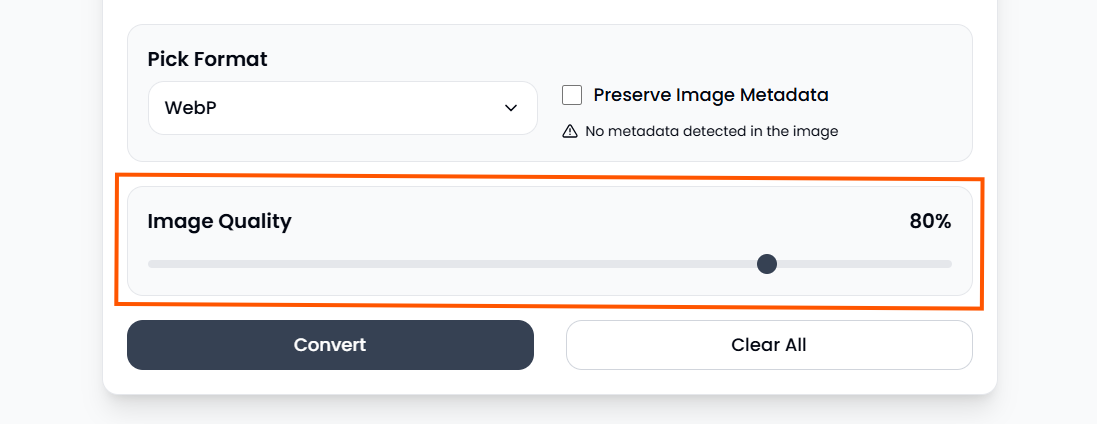
🔄 Step 5: Convert
Hit that Convert button and watch the magic happen. ImageToolo processes your image using advanced algorithms that preserve as much quality as possible during conversion. The entire process typically takes just 2-5 seconds, even for large files.
Behind the scenes, the tool is analyzing your image, applying the appropriate compression algorithm, adjusting color profiles if needed, and generating your new file in the format you selected.
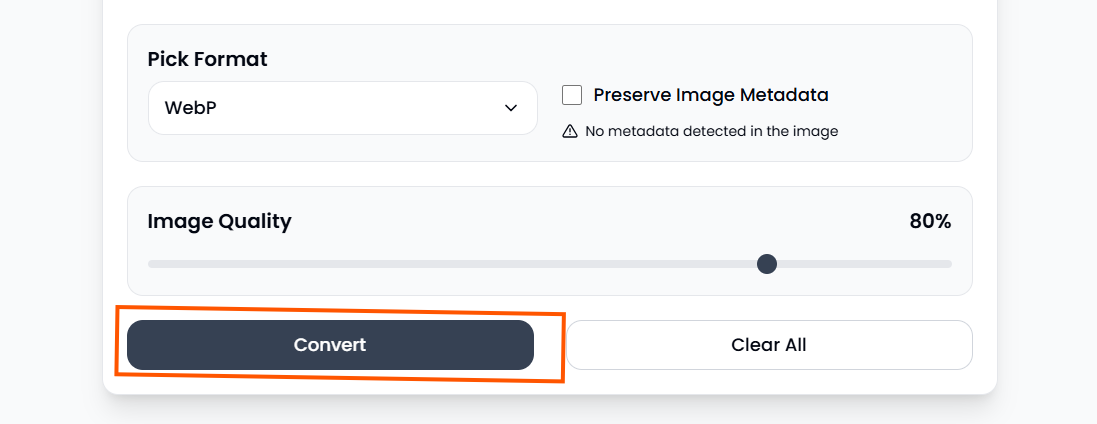
⬇️ Step 6: Download Your Converted Image
Once conversion completes, a download button appears. Click it to save your newly converted image to your device. The filename automatically includes the new format extension, so you'll never get confused about which file is which.
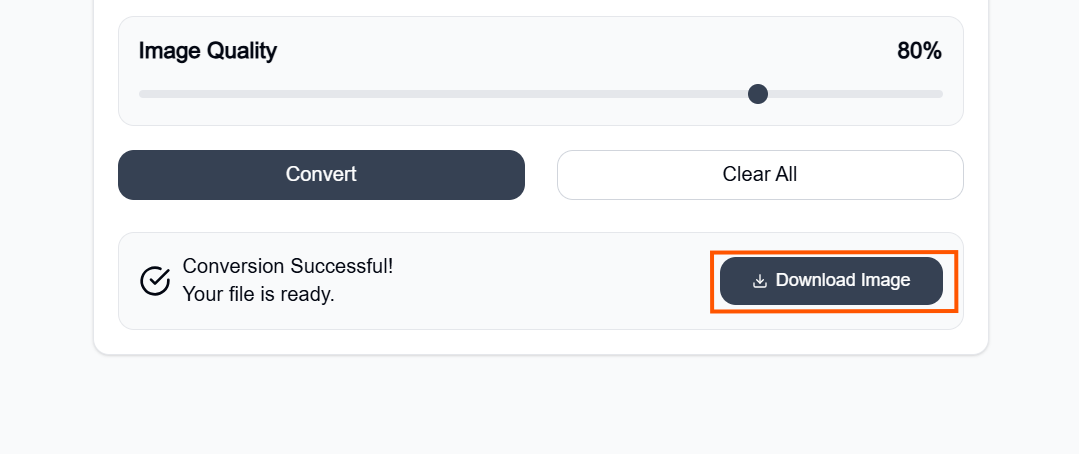
Want to convert more images? Just repeat the process. There's no limit to how many conversions you can perform, and you don't need to create an account or pay anything.
Understanding Image Formats: What They Are and Why They Matter
Before we jump into the conversion process, let's talk about what image formats actually are. Think of an image format as the "language" your image speaks. Just like humans communicate in different languages, images store their data in different ways.
The Most Common Image Formats
JPG (or JPEG): This is probably the format you're most familiar with. JPG is everywhere — from your phone's camera roll to website banners. It uses lossy compression, which means it reduces file size by discarding some data. This makes JPGs perfect for photographs where tiny quality losses aren't noticeable, but the smaller file size is appreciated.
PNG: Unlike JPG, PNG uses lossless compression. This means no quality is lost during compression. PNG also supports transparency, making it ideal for logos, graphics, and any image where you need a clear background. The downside? PNG files are typically much larger than JPGs.
WEBP: This is the new kid on the block, developed by Google. WEBP combines the best of both worlds — it offers better compression than JPG while supporting transparency like PNG. It's quickly becoming the go-to format for modern websites because it significantly improves loading speeds without sacrificing visual quality. For a deeper dive into these differences, check out our comparison of JPG vs PNG vs WEBP, and use our compression tool to optimize your images even further.
GIF: Remember those animated memes? That's GIF. While it supports animation, it only handles 256 colors, making it unsuitable for photographs but perfect for simple graphics and animations. For static images, you're better off using our converter to transform them into more efficient formats.
SVG: Scalable Vector Graphics are fundamentally different. Instead of storing pixels, they store mathematical formulas. This means SVG images can scale infinitely without losing quality. They're perfect for logos and icons but can't handle complex photographs.
TIFF: This format is the heavyweight champion of image quality. TIFF files are massive but preserve every single detail. Professional photographers and print designers love them, but they're overkill for everyday use.
Why Format Choice Matters
Choosing the right format isn't just about technical specifications — it directly impacts your work's success. A website with JPG images instead of WEBP might load three seconds slower, causing visitors to leave before they even see your content. A logo saved as JPG instead of PNG will have an ugly white box around it. A high-resolution photograph saved as PNG will eat up your storage space unnecessarily. Our guide to compressing images online explains how to optimize your images without quality loss.
Understanding these differences helps you make smart decisions about which format to use when, and when to convert between them. For specific use cases like printing, you might want to convert your images to PDF, while for web optimization, our best image compressor guide can help you make the right choices.
When Should You Change Image Formats?
Let's explore real-world scenarios where format conversion becomes necessary:
Website Optimization
You're building a website and want it to load lightning-fast. Converting your existing JPG and PNG images to WEBP can reduce file sizes by up to 30% without visible quality loss. This directly improves your Google PageSpeed score and user experience.
Email Attachments
Your colleague sent you a massive PNG file that's too large to email. Converting it to JPG shrinks it down to a manageable size while keeping it perfectly viewable.
Transparency Requirements
You've designed a logo as a JPG, but now realize you need a transparent background for it to work on different colored backgrounds. Converting to PNG with transparency solves this instantly.
Print vs. Web
Images destined for professional printing need different formats than those for websites. You might convert web-optimized JPGs back to high-quality TIFF or PNG files before sending them to a print shop.
Platform Requirements
Some platforms are picky about formats. LinkedIn might want JPG for profile pictures, while certain design tools prefer PNG. Being able to quickly convert between formats removes these roadblocks.
Storage Management
Your phone's storage is full of massive PNG screenshots. Converting them to JPG could free up gigabytes of space without noticeably affecting quality for personal use.
ImageToolo's Powerful Features That Set It Apart
What makes ImageToolo better than the dozens of other converters out there? Let's break down the features:
✨ Format Flexibility
ImageToolo supports all major image formats, plus some less common ones. Whether you're converting between common formats like JPG and PNG, or working with professional formats like TIFF and RAW, it handles them all.
🚀 Lightning-Fast Processing
Time is valuable. ImageToolo's optimized conversion engine processes images in seconds, not minutes. Even batch conversions of multiple files happen almost instantly.
🔒 Privacy-First Approach
Your images are your business. ImageToolo doesn't keep copies of your files, doesn't require account creation, and doesn't use your images for any purpose beyond conversion. Files are automatically deleted after processing.
📱 Works Everywhere
Whether you're on a Windows laptop, MacBook, iPhone, Android tablet, or Chromebook, ImageToolo works flawlessly in any modern browser. No app downloads, no compatibility issues.
💎 No Watermarks
Many free converters slap ugly watermarks on your converted images. Not ImageToolo. Your images come out clean and professional, ready to use immediately.
🎨 Quality Preservation
The conversion algorithms are designed to maintain maximum quality. When converting between lossless formats, zero quality is lost. When converting to lossy formats, intelligent optimization ensures the best possible result.
📦 Batch Conversion Support
Need to convert 50 images? No problem. Upload them all at once and convert them in a single operation. This feature alone saves hours for designers and content creators.
🆓 Completely Free
No hidden costs, no premium tiers, no subscription traps. Every feature is available to every user, forever.
Advanced Tips for Perfect Image Conversions
Want to get the absolute best results from your conversions? Follow these pro tips:
Start with Quality
Remember: conversion can't add quality that wasn't there originally. If you're starting with a low-resolution, pixelated image, converting it to a different format won't magically make it sharp. Always start with the highest quality source image available.
Understand Lossy vs. Lossless
When you convert from a lossless format (PNG) to a lossy format (JPG), you're permanently discarding some data. Converting back won't restore that data. If you might need maximum quality later, keep a copy of the original lossless version.
Use WEBP for Modern Web Projects
If you're building a website in 2025, WEBP should be your default choice for most images. It offers superior compression, broad browser support, and features like transparency. Your website will load faster and rank better in search results.
Consider Your Audience
Are you sharing images with older relatives who might use outdated devices? Stick with JPG or PNG for maximum compatibility. Working with other designers or developers? WEBP and modern formats are fine.
Don't Over-Compress
It's tempting to crank the compression all the way up to create tiny files, but excessive compression creates visible artifacts — blocky patterns, color banding, and fuzzy details. Find the balance between file size and visual quality.
Batch Rename Before Batch Converting
If you're converting multiple images, rename them systematically first (image_01, image_02, etc.). This keeps everything organized and makes it easier to identify converted files later.
Test on Target Platform
After converting, view your images on the actual platform where they'll be used. An image that looks perfect on your 4K monitor might reveal compression artifacts on a phone screen, or vice versa.
Common Conversion Scenarios and Solutions
Let's tackle some specific conversion challenges you might face:
Converting JPG to PNG for Transparency
This is one of the most common conversions, but here's the catch: JPG doesn't store transparency information. When you convert JPG to PNG, the background will still be there — it just becomes part of the PNG. If you need actual transparency, you'll need to manually remove the background first using an image editor or background removal tool.
Converting PNG to JPG to Reduce Size
This works great for photographs but less well for graphics with text or sharp edges. When converting, ensure the quality setting is at least 85% to avoid visible artifacts around text and lines.
Converting Any Format to WEBP
This is usually a win-win situation. WEBP handles both photographs and graphics well, creates smaller files than JPG or PNG, and supports transparency. The only consideration is ensuring your target platform supports WEBP (most modern websites and apps do).
Converting GIF to Video Formats
Animated GIFs are notoriously large and inefficient. While not technically an image format conversion, consider converting GIFs to MP4 or WEBM video formats for much smaller file sizes with better quality.
Converting Screenshots
Screenshots are typically saved as PNG on most devices. For documentation or sharing, converting to JPG reduces file size significantly. However, if the screenshot contains text you want to remain crisp, stick with PNG or WEBP.
How Image Format Choice Impacts Your Work
The format you choose has ripple effects across your entire project. Let's explore how:
Website Performance and SEO
Google explicitly states that page speed is a ranking factor. Images are often the largest files on web pages. By converting to optimized formats like WEBP, you can reduce total page size by 40-60%, dramatically improving load times. Faster sites rank higher, get more traffic, and convert better.
Storage Costs
Cloud storage isn't free. If you're storing thousands of images on AWS, Google Cloud, or similar services, format choice directly impacts your monthly bill. Converting from PNG to WEBP for images that don't need lossless quality could cut your storage costs in half.
User Experience
Mobile users on slower connections will abandon pages that take too long to load. By using optimized image formats, you ensure everyone can access your content quickly, regardless of their connection speed.
Professional Perception
Sending properly formatted images shows attention to detail. Knowing when to use which format demonstrates professionalism, whether you're a freelancer submitting work to clients or a marketer creating campaign materials.
Workflow Efficiency
When everyone on your team uses consistent image formats, collaboration becomes smoother. Files open quickly, share easily, and integrate seamlessly into projects.
Troubleshooting Common Conversion Issues
Even with the best tools, you might encounter hiccups. Here's how to solve them:
Problem: Converted image looks blurry or pixelated Solution: The source image was low quality to begin with, or compression was too aggressive. Try converting again with a higher quality setting, or use a higher resolution source image. For better control over quality, use our image compressor with fine-tuned settings, or check our guide on the best image compression techniques.
Problem: File size increased after conversion Solution: You likely converted from a lossy format (JPG) to a lossless one (PNG). This is expected. If file size is important, convert to WEBP with moderate compression instead. Learn more about format differences in our JPG vs PNG vs WEBP guide.
Problem: Colors look different after conversion Solution: This might be a color profile issue. Some formats handle color spaces differently. Try converting again and ensure the color profile is set correctly, or stick with RGB for web use. For accurate color sampling, you can use our color picker tool.
Problem: Transparency disappeared after conversion Solution: You converted to a format that doesn't support transparency (like JPG). Convert to PNG or WEBP instead to preserve transparency.
Problem: Conversion failed or produced errors Solution: The source file might be corrupted, or the format might not be supported. Try opening the image in an image editor first, then save it again before attempting conversion.
The Future of Image Formats
Image technology continues evolving. Here's what's coming:
AVIF: This newer format promises even better compression than WEBP, though browser support is still growing. Within a year or two, AVIF might become the new standard.
JPEG XL: Designed as the successor to classic JPEG, this format offers significantly better compression and quality. Adoption has been slow but steady.
AI-Powered Conversion: Future converters will use artificial intelligence to intelligently enhance images during conversion, recovering lost details and improving quality beyond what traditional algorithms can achieve.
Staying flexible with your format choices and using tools like ImageToolo that support multiple formats ensures you'll be ready for whatever the future brings.
Final Thoughts
Changing image formats doesn't have to be a technical headache. With ImageToolo's free online converter, you can transform any image to any format in seconds — no software installation, no complicated settings, no learning curve.
Whether you're a web designer optimizing site performance, a photographer preparing images for print, a student working on presentations, or anyone who regularly deals with digital images, knowing how to convert formats efficiently is an invaluable skill.
The key takeaways? Use WEBP for websites, PNG for graphics with transparency, JPG for photographs where some compression is acceptable, and always keep a high-quality master copy of important images before converting.
Ready to start converting? Head over to ImageToolo Image Converter and experience the easiest way to change image formats online. It's fast, secure, and powerful — everything you need in a modern image tool.
Looking to do more with your images? Explore our complete suite of tools:
- Compress Images to reduce file size without losing quality
- Resize Images to perfect dimensions
- Crop Images for ideal composition
- Convert to PDF for professional documents
- Split Images for creative projects
- Add Watermarks for branding
For more insights, check out our related guides:
- How to Compress Images
- Understanding Image Formats
- Converting Images to PDF
- The Best Image Compression Guide
Stop letting image format issues slow you down. Take control of your images today and convert them to exactly what you need, whenever you need it.